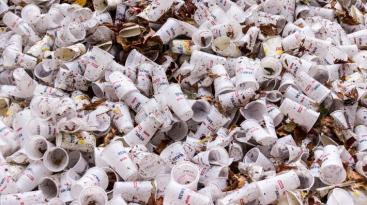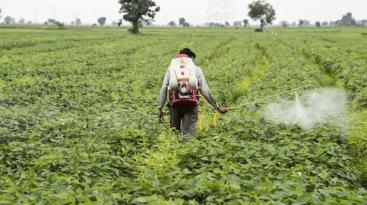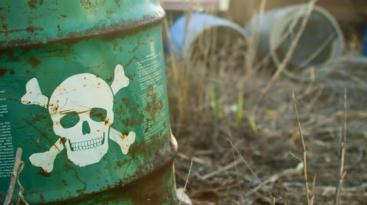Today’s Menu: Pesticide Salad, Leaded Fish with Plastic, and Intoxicated Fruit
TRANSCEND MEMBERS, 8 Jul 2019
Baher Kamal - Human Wrongs Watch
The amazing impact of a 10 trillion dollars-worth chemical industry.
7 Jul 2019 – In case you were not aware or just do not remember: all you eat, drink, breathe, wear, take as a medicine, the cosmetics you use, the walls of your house, among others, is full of chemicals.
And all is really ALL.
For instance, in your bathroom, formaldehyde often sits in your shampoo, microbeads in your toothpaste, phthalates in your nail polish and antimicrobials in your soaps, while your medicine cabinet contains a myriad of synthetic pharmaceuticals.
In your kitchen, a juicy strawberry may carry traces of up to 20 different pesticides.
And the perfumed bin-liners and air fresheners contain volatile organic compounds that can make you nauseous and give you a headache. And the list goes on…
Who tells all these and many other shocking facts is one of the top world organisations dealing with the sources and dangers of pollution and contamination – the UN Environment, which on 29 April 2019 released its Global Chemicals Outlook.
Chemicals, chemicals, chemicals everywhere
See what Tanzanian microbiologist and environmental scientist Joyce Msuya, the Deputy Executive Director of the United Nations Environment Programme, said in her introduction to this report:
“Chemicals are part of our everyday lives. From pharmaceuticals to plant protection, innovations in chemistry can improve our health, food security and much more. However, if poorly used and managed, hazardous chemicals and waste threaten human health and the environment.
“As the second Global Chemicals Outlook lays out, global trends such as population dynamics, urbanisation and economic growth are rapidly increasing chemical use, particularly in emerging economies.
“In 2017, the industry was worth more than 5 trillion dollars. By 2030, this will double.
“Large quantities of hazardous chemicals and pollutants continue to leak into the environment, contaminating food chains and accumulating in our bodies, where they do serious damage.
“Estimates by the European Environment Agency suggest that 62 per cent of the volume of chemicals consumed in Europe in 2016 were hazardous to health.
“The World Health Organization estimates the burden of disease from selected chemicals at 1.6 million lives in 2016. The lives of many more are negatively impacted…”
Referring to the agreed objective that, by 2020, chemicals will be produced and used in ways that minimise significant adverse effects on the environment and human health, Joyce Msuya warned “At our current pace, we will not achieve the goal.”
Key findings
The following are three key findings included in the report, among many others.
One is that the size of the global chemical industry exceeded 5 trillion dollars in 2017. It is projected to double by 2030. Consumption and production are rapidly increasing in emerging economies. Global supply chains, and the trade of chemicals and products, are becoming increasingly complex.
Another one is that, driven by global mega-trends, growth in chemical-intensive industry sectors (e.g. construction, agriculture, electronics) creates risks, but also opportunities to advance sustainable consumption, production and product innovation.
And a third one is that hazardous chemicals and other pollutants (e.g. plastic waste and pharmaceutical pollutants) continue to be released in large quantities. They are ubiquitous in humans and the environment and are accumulating in material stocks and products, highlighting the need to avoid future legacies through sustainable materials management and circular business models.
The Global Chemicals Outlook covers three broad inter-linked areas building upon the findings of existing and concurrent studies:
Production, trade, use and disposal of chemicals
Both the continuous growth trends and the changes in global production, trade and use of chemicals point towards an increasing chemical intensification of the economy.
This chemical intensification of the economy derives largely from several factors, such as the increased volume and a shift of production and use from highly industrialised countries to developing countries and countries in economic transition.
Another factor is the penetration of chemical intensive products into national economies through globalisation of sales and use.
Then there are the increased chemical emissions resulting from major economic development sectors.
According to the report, products of the chemical industry that are increasingly replacing natural materials in both industrial and commercial products.
Thus, petrochemical lubricants, coatings, adhesives, inks, dyes, creams, gels, soaps, detergents, fragrances and plastics are replacing conventional plant, animal and ceramic based products.
Industries and research institutions which are increasingly developing sophisticated and novel nano-scale chemicals and synthetic halogenated compounds that are creating new functions such as durable, non-stick, stain resistant, fire retardant, water-resistant, non-corrosive surfaces, and metallic, conductive compounds that are central to integrated circuits used in cars, cell phones, and computers.

Bamako Convention: Preventing Africa from becoming a dumping ground for toxic wastes. Image from UN Environment.
Penetration of chemical intensive products
The Global Outlook also informs that many countries are primarily importers of chemicals and are not significant producers. Agricultural chemicals and pesticides used in farming were among the first synthetic chemicals to be actively exported to developing countries.
Today, as consumption of a wide range of products increases over time, these products themselves become a significant vehicle increasing the presence of chemicals in developing and transition economies, the report explains, adding the following information:
- These include liquid chemical personal care products for sale directly to consumers; paints, adhesives and lubricants; as well as chemically complex articles ranging from textiles and electronics, to building materials and toys.
- Emissions from products pose different management challenges from those associated with manufacturing, as they are diffused throughout the economy, rather than being concentrated at manufacturing facilities.
- Trade in articles has been identified as a significant driver of global transport of lead, cadmium, mercury and brominated flame retardants.
- It is often the case that electrical and electronic equipment, which contain hazardous or toxic substances, are purchased in developed countries before being disposed of or recycled in unsafe and unprotected conditions in developing states or countries with economies in transition.
- Products such as cell phones and laptops are being purchased and used in regions of the world recently thought to be too remote.
- Increasing consumer demand for electrical/electronic goods and materials, along with rapid technology change and the high obsolescence rate of these items have led to the increasing generation of large quantities of obsolete and near end of life electronic products.
- These trends contribute to global electronic waste generation estimated at 40 million tons per year.
Chemical contamination and waste associated with industrial sectors of importance in developing countries include: pesticides from agricultural runoff; heavy metals associated with cement production; dioxin associated with electronics recycling; mercury and other heavy metals associated with mining and coal combustion, explains the Global Outlook.
They also include: butyl tins, heavy metals, and asbestos released during ship breaking; heavy metals associated with tanneries; mutagenic dyes, heavy metals and other pollutants associated with textile production.
They also include: toxic metals, solvents, polymers, and flame retardants used in electronics manufacturing, and the direct exposure resulting from the long range transport of many chemicals through environmental media that deliver chemical pollutants which originate from sources thousands of kilometres away.

Governments agree landmark decisions to protect people and planet from hazardous chemicals and waste, including plastic waste.
UN Environment.
Health and environmental effects
According to the report:
- Chemicals released to the air can act as air pollutants as well as greenhouse gases and ozone depleters and contribute to acid rain formation.
- Chemicals can contaminate water resources through direct discharges to bodies of water, or via deposition of air contaminants to water. This contamination can have adverse effects on aquatic organisms, including fish, and on the availability of water resources for drinking, bathing, and other activities.
- It is common for soil pollution to be a direct result of atmospheric deposition, dumping of waste, spills from industrial or waste facilities, mining activities, contaminated water, or pesticides.
- Persistent and bio-accumulative chemicals are found as widespread contaminants in wildlife, especially those that are high in the food chain. Some of these chemicals cause cancers, immune system dysfunction, and reproductive disorders in wildlife.
- In some countries, the runoff of pesticides and fertilisers from agricultural fields or the use of chemicals in mining in neighbouring countries, may leach into ground water, or run into estuaries shared across national boundaries.
- Fisheries, an important source of protein and of economic value for populations around the world, can be severely affected by chemicals. Persistent organic pollutants can accumulate in fish, especially those high in the food chain. As a result, the value of this otherwise excellent protein source is diminished or lost completely.
- Exposure to toxic chemicals can cause or contribute to a broad range of health outcomes. These include eye, skin, and respiratory irritation; damage to organs such as the brain, lungs, liver or kidneys; damage to the immune, respiratory, cardiovascular, nervous, reproductive or endocrine systems; and birth defects and chronic diseases, such as cancer, asthma, or diabetes.
- Workers in industries using chemicals are especially vulnerable through exposure to toxic chemicals and related health effects.
This exposure includes an increased cancer rate in workers in electronics facilities; high blood lead levels among workers at lead-acid battery manufacturing and recycling plants; flame retardant exposures among workers in electronic waste recycling.
It also includes: mercury poisoning in small-scale gold miners; asbestosis among workers employed in asbestos mining and milling; and acute and chronic pesticide poisoning among workers in agriculture in many countries.
In spite of these and other immense negative impacts on health and the environment, the more than 400 scientists and experts around the world, who worked over three long years to prepare the Global Chemicals Outlook, underscore that the goal to minimise adverse impacts of chemicals and waste will not be achieved by 2020.
“Solutions exist,” the 400 world experts emphasise, “but more ambitious worldwide action by all stakeholders is urgently required.”
Otherwise…
_____________________________________________
 Baher Kamal, a member of the TRANSCEND Network for Peace Development Environment, is an Egyptian-born, Spanish national, secular journalist, with over 45 years of professional experience — from reporter to special envoy to chief editor of national dailies and an international news agency. Baher is former Senior Advisor to the Director General of the international news agency IPS (Inter Press Service) and he also contributed to prestigious magazines such as TRANSCEND Media Service, GEO, Muy Interesante, and Natura, Spain. He is also publisher and editor of Human Wrongs Watch.
Baher Kamal, a member of the TRANSCEND Network for Peace Development Environment, is an Egyptian-born, Spanish national, secular journalist, with over 45 years of professional experience — from reporter to special envoy to chief editor of national dailies and an international news agency. Baher is former Senior Advisor to the Director General of the international news agency IPS (Inter Press Service) and he also contributed to prestigious magazines such as TRANSCEND Media Service, GEO, Muy Interesante, and Natura, Spain. He is also publisher and editor of Human Wrongs Watch.
Go to Original – human-wrongs-watch.net
Tags: Chemical waste, Development, Environment, Oceans, Plastic Pollution, Politics, Pollution, Power, West, World
DISCLAIMER: The statements, views and opinions expressed in pieces republished here are solely those of the authors and do not necessarily represent those of TMS. In accordance with title 17 U.S.C. section 107, this material is distributed without profit to those who have expressed a prior interest in receiving the included information for research and educational purposes. TMS has no affiliation whatsoever with the originator of this article nor is TMS endorsed or sponsored by the originator. “GO TO ORIGINAL” links are provided as a convenience to our readers and allow for verification of authenticity. However, as originating pages are often updated by their originating host sites, the versions posted may not match the versions our readers view when clicking the “GO TO ORIGINAL” links. This site contains copyrighted material the use of which has not always been specifically authorized by the copyright owner. We are making such material available in our efforts to advance understanding of environmental, political, human rights, economic, democracy, scientific, and social justice issues, etc. We believe this constitutes a ‘fair use’ of any such copyrighted material as provided for in section 107 of the US Copyright Law. In accordance with Title 17 U.S.C. Section 107, the material on this site is distributed without profit to those who have expressed a prior interest in receiving the included information for research and educational purposes. For more information go to: http://www.law.cornell.edu/uscode/17/107.shtml. If you wish to use copyrighted material from this site for purposes of your own that go beyond ‘fair use’, you must obtain permission from the copyright owner.





